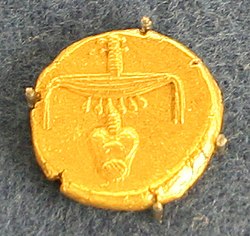Gold stater
| Gold stater in hieroglyphics | ||||
|---|---|---|---|---|
Nefer-nub Nfr-nwb Good gold |
||||
|
Gold stater of Nectanebo II ( Kestner Museum , Hanover ) |
||||
The gold stater ( ancient Egyptian Nefer-nub ) was established between 361 and 359 BC. The first coin in ancient Egypt was introduced by Pharaoh (King) Tachos .
Gold stater in ancient Egypt
With the introduction of the gold stater, Tachos laid the foundation for a separate coin currency in ancient Egypt. The reason for the introduction of the gold stater was the remuneration of the numerous employed mercenaries who performed their military services for Egypt.
Speedometers
- Gold stater with the weight of a darikos : weight about 8.42 grams, according to the Athenian model with an owl on the right, with papyrus on the left
- Gold stater as a tetradrachm : on the right with an owl, on the left with an olive branch, on the right in demotic writing “Tachos ... Pharao”.
Nectanebo II
Nektanebo II took over the speedometer system, but introduced his own gold stater coins:
- Gold stater: weight about 8.42 grams, depicted on the front a horse jumping to the right; Reverse with the Egyptian hieroglyphs "Nefer-nub".
- Gold stater as a small coin: Weight about 2.56 grams, 14-15 millimeters . Probable image of a gazelle leaping to the left , plus a beam balance, including three points. The assignment to Nektanebo II is not certain.
literature
- Ernst Gölitzer: Origin and development of the Alexandrian coinage from 30 BC Until the end of the Julio-Claudian dynasty. Akademie-Verlag, Berlin 2004, ISBN 3-05-004089-0 , p. 6 (also: Mainz, Univ., Diss., 2002).
